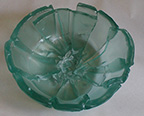
Glass Fusing Basic Overview
Glass fusing is an ancient process that became very popular again in the 20th century. There is evidence of glass fusing that dates back to 2000 BC in the Egyptian tombs. Some say it even predates that time period. Fused glass is sometimes referred to as kiln formed or warm glass, distinguishing it from cold working glass techniques like stained glass or etching, and hot glass techniques like glass blowing. Although I personally think 1500 degree is still pretty hot!

Glass fusing is a process of layering glass pieces in a kiln and firing it to around 1500 degrees to melt the pieces together. The temperatures involved can vary based on the desired look you are going for. Lower temperatures are used for slumping glass which is bending or shaping a piece of glass into a mold; this would be in the 1100 to 1200 range. Lower temperatures are also used for tack fusing. This is when the glass pieces are melted together but not fully and there is still some distinction between the individual layers. Tack fusing takes place in the 1250 to 1350 range. 1475 to 1525 is a typical range for a full fusing of the glass. This is the point were the individual pieces become one. Higher temperatures can also be used for other techniques like Raking or Combing. Raking glass involves puling an instrument through the molten glass to blend colors and create designs. This kind of technique is generally done at around 1600 to 1650 degrees. All of the temperatures listed are approximate and can vary based on the kiln and the type of glass you are using.

After you have incorporated any techniques required to achieve the desire appearance of the piece in the heating process, you must anneal the glass. Annealing is a multi-stage process of cooling the glass back to room temperature. The heating and annealing process is called a firing schedule. The schedule can vary a great deal based on the type of glass, thickness of the finished piece, as well as other factors. If you go through the process to quickly your piece will break. The glass needs to be cooled in stages and held at certain temperatures to allow the heat to even out throughout the entire piece and then slowly brought back to room temperature.

This is a sample firing schedule that we use in the studio for firing a 1/4" thick 12" x 12" piece, using 90 COE glass.
Heating segments of the firing schedule.
1. 300 degrees per hour to 900 degrees. Hold at 900 degrees for 20 minutes.
2. 500 degrees per hour to 1050 degrees. No Hold time needed.
3. 100 degrees per hour to 1250 degrees. Hold at 1250 for 30 minutes.
4. As fast as possible to 1475 degrees. Hold at 1475 for 10 to 15 minutes.
Annealing segments of the firing schedule.
5. As fast as possible to 960. Hold at 960 for 60 minutes.
6. 100 degrees per hour to 700 degrees. No hold time needed.
7. 350 degrees per hour to 100 degrees.
You will notice that the initial heating is done slowly. This brings the glass gradually through the "thermal shock" range. Thermal shock happens when the glass is heated to quickly causing it to break. In step 2 the heating is sped up because the glass is past the range where it is easily shocked. The heating speed is slowed in step 3 because this is the range of temperature at which the pieces start to move and seal together. Slowing the heating speed allows the glass to squeeze out air between the pieces, so this step this is called the bubble squeeze. Step 4 speeds the heating up to as fast as your kiln will go. At this point the glass is basically sealed together. At this point any trapped air bubbles are not coming out. Unless of course they decide to reach the surface through the glass and pop. This does happen, and has ruined many fused glass projects over the years.
The hold times in the different segments are to allow the heat to be evenly distributed throughout the entire piece.
Step 5 begins the annealing stages of the schedule. You bring the piece down to 960 degrees as fast as possible. Some people open the kiln to do this, I personally don't recommend doing that; the kiln will cool fairly quickly on its own. The hold time once again allows the heat to even out through the entire piece. In step 6 you start controlling the rate of decent so that the glass does not break on the way down. Different colors of glass can harden at different temperatures so this segment allows it to happen slowly causing as little stress as possible to the now fused glasses. Finally, step 7 continues the cool down to room temperature without thermal shocking the glass. Now you get to look in the kiln and see if your masterpiece turned out how you hoped it would.

For information on some cool techniques and glass fusing materials click here.
| Home | Stained Glass Windows | Beveled Windows | Etchings and Carvings |
| Fused and Bent Glass | Mosaics | Lamps | Ordering Custom Work |
| Religious Works | Restoration and Protective Glazing | Great Links | Resume |
| Special Events and Info | Like us on
|
Follow us on |
Connect with us on |